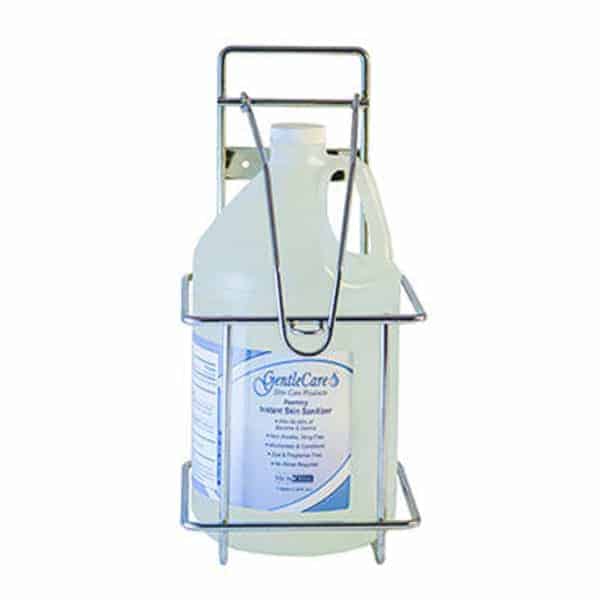
A COMPREHENSIVE HAND HYGIENE PROGRAM TO REDUCE INFECTION RATE IN DAYCARE CENTERS
GentleCare Alcohol Free Hand Sanitizer was used in the production of this document.
A Research Utilization Project by:
Elaine B. Suderio-Tirone, BSN, RN
Submitted to the Division of Nursing
Mount Saint Mary College
in partial fulfillment
of the requirements for the degree of
Master of Science in Nursing Spring 2010
Introduction: The most current public health threat is swine flu. The Morbidity and Mortality Weekly Report (MMWR) (2009) indicated that the pandemic of the influenza virus has rapidly spread across the world and surveillance data suggests that its spread among communities has continued. This is just one example of an infection spread from one person to another. As a pediatric nurse, I have seen an increase in hospital admissions among children (and/or their siblings) who attend child care facilities. In light of the current situation regarding the spread of communicable illnesses, effective prevention of disease transmission is essential. According to the Centers for Disease Control and Prevention (CDC) (2009), handwashing, when performed in a proper manner, remains the single most effective means to prevent the spread of communicable diseases.
As with many places where there is much human-to-human contact, the probability of transmissible infection in childcare facilities is consistently high. There is a greater risk of respiratory and gastrointestinal diseases among children cared for in groups outside the home which can easily be transmitted to other family members. Children are at high risk of contracting communicable diseases especially in daycare settings where they readily exchange secretions, contaminated toys and books. In order for a disease to occur, a potentially pathogenic organism needs to migrate from one place to another (Boyce & Pittet, 2000). The hands are excellent vehicles of this migration process having the ability to reach areas that are less accessible, such as the inside of the nose or the groin. The purpose of measures like hand hygiene is to eradicate the source of microbes or disrupt the chain of transmission (Clayton-Kent, 2004). Efforts to encourage or even enforce handwashing with soap and water are often hindered by the inherent inconvenience of the activity. Though few doubt the efficacy of handwashing, hand sanitizers do not require the sink, water, drying mechanisms and time that handwashing does (Sandora et al., 2005).
Education and training of staff in hand hygiene has been a main focus of infection control programs. Failure to perform appropriate hand hygiene is considered the leading cause of infections and spread of disease-causing organisms and has been recognized as a substantial contributor to outbreaks (LeTexier, 2000).
With the recent alarming concern of high incidence of infection-related illnesses a comprehensive hand hygiene teaching program and a use of instant hand sanitizer may be beneficial to reduce incidence of transmitted illnesses. Therefore, the purpose of this research utilization project is to increase knowledge of staff members regarding hand hygiene, decrease the rate of infection and consequently reduce infection-related absenteeism in daycare centers.
Review of Literature:
The Department of Health recommended the evidence-based practice in infection control guidelines (Department of Health, 2001) which specified that effective hand hygiene significantly decreases the transmission of potential pathogenic microorganisms on the hands. Improving hand hygiene is also an integral component of clinical practice (Pratt, 2001 as cited in Clayton-Kent, 2004). The Association of Professionals in Infection Control and Epidemiology (APIC) is in agreement with the CDC that handwashing reduces carriage of potential pathogens on the hands, can make a critical difference in reducing the incidence of infections (APIC, 2009).
Using an open-label crossover design study in a school of 420 students, Dyer, Shinder & Shinder (2000) evaluated the use of an alcohol-free sanitizer as an adjunct to regular handwashing. In this study, students in the product group were provided with an individual spray bottle of sanitizer (CleanHands) with instructions to apply one to two sprays to the hands after coming into the classroom, before eating and after using the restroom, in addition to their normal handwashing routine using non-medicated soap. After four weeks of treatment and a two-week wash-out period, the two groups were reversed. The teachers monitored the student attendance. Students of the intervention group were found to have 41.9% fewer days of absenteeism due to infectious illness. The incidence of absenteeism decreased by 31.7%. It was concluded that daily use of hand sanitizer was linked to a markedly lower rate of illness-related absenteeism.
White, Shinder, Shinder and Dyer (2001) conducted a double-blind, placebo controlled study to assess the reduction of illness absenteeism in elementary schools using an alcohol-free instant hand sanitizer containing surfactants, allantoin, and benzalkonium chloride. Seven hundred sixty nine elementary students were educated about proper hand washing technique and the importance of handwashing to prevent germ transmission. The relationship between germs and illnesses was also discussed. Students were randomly assigned to the active and placebo hand sanitizer product. Data on illness absenteeism were collected for five weeks. The results of the study indicated that students using the active product were 33% less likely to have been absent because of illness when compared with the placebo group.
Scientific Merit of Primary Studies
4 Dyer, Shinder, and Shinder (2000) conducted a ten-week, open-label, crossover study on 420 elementary school-age children. The hypothesis of the study was clearly stated. The study had an adequate and appropriate sample size. There were experimental and control groups. There was a thorough discussion on the methodology of the study. Data analysis was transparently provided using tables and charts. The statistical significance was measured using a chi-square analysis. The hypothesis of the study was strongly supported by the results. The results of the study showed a statistically significant decrease in absenteeism related to illness with the group using hand sanitizer as an adjunct to handwashing. The researchers listed the limitations including limited socioeconomic diversity in the study population, limitation to a single study site and lack of blinding. In spite of the limitations of this study, it is still strong enough to support this research utilization (RU) project. The strengths of the study include the use of prospective, controlled experimental design, use of valid and reliable method to measure statistical significance and adequacy of the sample size.
White, Shinder, Shinder and Dyer (2001) investigated a reduction of illness absenteeism in elementary schools using an alcohol-free instant hand sanitizer. White and colleagues conducted a double-blind, placebo-controlled study to evaluate the effectiveness of adding a hand sanitizer to routine hand washing. The total number of participants were 769 elementary school students. There was a comprehensive discussion of the methodologies of the research process. Prior to conducting this study, students received a half-hour educational program on the use of a hand sanitizer. All students were supervised in the use of the hand sanitizer or placebo six times per day and were allowed to wash their hands at will without supervision. Data collection, interpretation and 5 analysis were clearly discussed in a separate section of the research report. The results were well presented using a chi-square analysis. The results of the study indicated a 31.1% difference in student absences related to illness for the hand sanitizer group (N = 381) compared to the control group (N = 388). The limitations of the study include a lack of monitoring in the use of soap and water washing versus both methods of hand hygiene, and a reduced number of participants due to non-compliance in the practice protocol. These limitations however, did not affect the strength of the study on which this research utilization project is based. In summary, the strengths of the study include adequate and appropriate sample size and the use of double-blind, controlled experimental design.
Implementation:
The RU project was implemented in three nursery and pre-school settings. The participants included 188 children and staff.
Transferability
This hand hygiene research utilization project had a good implementation potential. As illustrated in the literature review, the research findings were transferable to the project setting. The population group involved in the project was similar to those cited in the research studies. The staff, children and their respective families would benefit from the project. There was an adequate and realistic timeframe to complete the whole project. One week was allotted for providing education on hand hygiene and sending out notes to the parents. Two eight-week periods were used to collect baseline data and intervention implementation respectively. Another week culminated the project including process evaluation.
Feasibility
The feasibility of this RU project was good although it required of the daycare staff a minimal additional task, such as continuously supervising the students’ performance of proper hand hygiene technique. They also recorded infection-related illnesses. Additional knowledge on hand hygiene was provided to enhance the skills of the staff. This education did not require the staff to give additional time outside their work schedule, since it was provided during class hours. The directors of the pre-schools showed interest and support for the project.
Cost/Benefit Ratio
The potential identified risk to the participants associated with the implementation of this intervention was possible allergic reaction to the intervention product. The students and staff were educated on reportable signs and symptoms of allergic reaction such as skin erythema, rashes, hives and edema. Any observed symptoms would be reported to the day care and project directors. No one developed any reaction to the intervention product.
The potential benefits as a result of this project would be monetary savings from actual costs of medical interventions, hospitalizations, babysitting expenses and loss of income from parents’ absence from work. The expected non-material benefits of the project implementation included the reduction of infection incidence, increased school attendance and improved daily lifestyle function. Conversely, without the implementation of this project, the children would potentially contract easily transmitted illnesses that would increase school absences. Parents would spend their workday at home to take care of the child. There could also be additional spending on medications and co-pay for physician and emergency room visits. The family as a whole would experience emotional and mental stress as a result of the illness and disruption of the family daily routine.
Expected Outcomes of the RU Project
The expected outcomes of the hand hygiene RU project were:
- increased knowledge among staff members regarding hand hygiene.
- reduced infection rate of staff and children in the day care setting and consequently reduced infection-related absenteeism.
Practice Protocol of the Project
Permission to participate in the project was obtained from all staff members including a consent to take a pre and post-test on hand hygiene knowledge. Both tests were administered by the project director. Consents were sent out to the parents of the children attending the pre-schools. All parents and guardians were also provided with instructions for reportable illnesses. The daycare secretary took note of such absences specifying the symptoms. The children and staff were then oriented to proper handwashing techniques, use of non-alcohol based hand sanitizer (GentleCare) and its relationship to germs and illnesses. The in-service was in a form of class discussion, video presentation and actual demonstration. The hand hygiene activity pamphlet was designed to be creative to enhance fun learning for school-aged children. The project director personally taught the proper handwashing techniques and use of hand sanitizer.
Hand hygiene campaign posters were displayed in the daycare premises. After eight weeks of collecting baseline data of the daycare facilities’ infection rate, the hand sanitizer dispensers were installed on the wall in all the daycare rooms. The sanitizers were installed a day prior to the start of the intervention. On the education day, the staff 8 of the daycare facility took the hand hygiene pretest. The hand hygiene pamphlets were then distributed to the all the staff. A hand hygiene video presentation followed by a brief lecture-discussion was given to the staff and the children. The lecture included the step-by-step instructions on when and how to properly wash the hands and use the hand sanitizer (GentleCare). A post-test was given to all the staff once the lecture was completed. For the next eight subsequent weeks, the staff and the children were required to follow the handwashing protocol as per the educational instructions provided. The children were supervised by the staff. The daycare directors were required to keep a weekly log of infection-related absences of the staff and children. A weekly follow-up with the daycare directors was conducted to address concerns and to check the flow of the project, which lasted eight weeks. Once the intervention period was completed, post intervention data were compared with pre-intervention data.
Timeline
The over-all timeframe of this RU project was 17 weeks from November 2009 to March 2010. The Mount Saint Mary College Faculty Review Committee approved the research utilization project on December 2009. A letter of approval from the Mount Saint Mary College Institutional Review Board was received thereafter. The project director met with the pre-school directors on November 12, 2009 and provided them with a letter to participate. In the beginning of December, letters that described the project were delivered by the children to their parents or guardians. Baseline data were collected from November 1, 2009 to December 31, 2009. The project director gave the in-service regarding hand hygiene to the daycare director, staff and children on January 4-6, 2010 in three daycare facilities.
The hand hygiene intervention and ongoing recording of infection-related absences occurred from the first week of January 2010 to the beginning of March 2010. The project evaluation followed on March 8, 2010.
Evaluation The first expected outcome of this RU project was increased knowledge among staff members regarding hand hygiene. This expected outcome was evaluated by comparing pre-intervention data with post-intervention data. Pre-intervention data consisted of scores of the hand hygiene pre-test. Post-intervention data consisted of scores of the hand hygiene post-test. The highest score for the pre-intervention test was four out of six. Fifteen out of 47 staff members got the highest score. The 21 staff members got a score of three and the remaining 11 got a score of two. In the post-test, forty staff members obtained perfect scores and seven got five correct answers. There was a marked improvement in the post-test scores compared with the pre-test scores which is depicted in the charts below. This comparison indicates that the first expected outcome was achieved.
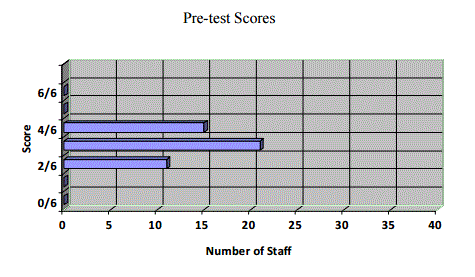

The second outcome of this RU project was reduced infection rate of staff and children in the day care setting and consequently reduced infection-related absenteeism. This outcome was measured by comparing the pre-intervention data with the data collected during the time covered by the implementation of the hand hygiene program. The pre-intervention data consisted of number of absences among staff and children in three different facilities. The data collected during the hand hygiene program consisted of number of staff and children absences related to infection for eight weeks. The preintervention total number of absences related to communicable illnesses among staff and children in all three daycare facilities was 144. Out of 144, 16 were staff and 128 were children. During the intervention period, the total number of absences was 78 of whom eight were staff and 70 were children. Below are graphs that depict the comparison of the pre-intervention data with data collected during the intervention. As shown, there is a marked decline in the number of infection-related absences. This comparison indicates that the second expected outcome was achieved.
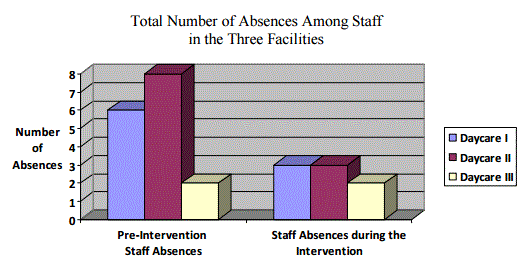
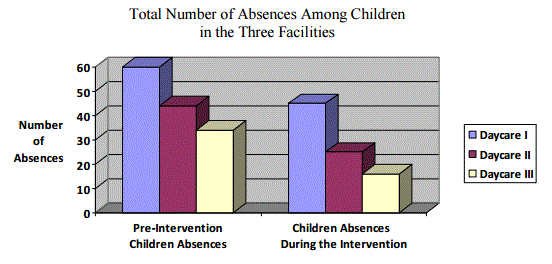
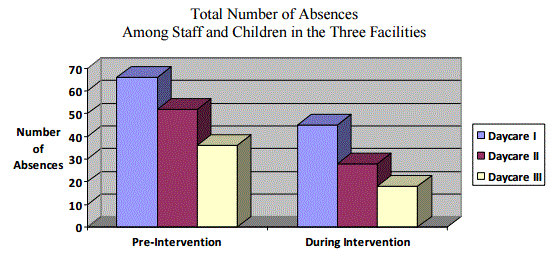
The overall total shows 154 illness-related absences in the pre-intervention period to 91 during the intervention period. There is a 41% drop in the overall total number of infection-related absences as depicted in the chart below.
Combined Total Number of Absences
After the completion of the RU project, the project director had the daycare directors complete a questionnaire to evaluate the project implementation process.
The results of the survey indicated that the directors were satisfied with the implementation process. They also expressed satisfaction of the outcome of the project. The directors indicated that the RU project purpose was clearly presented and the scope of their participation and responsibilities were adequately explained by the project director prior to the implementation of the project. The daycare directors were pleased about the project director’s accessibility through telephone, electronic mail and periodic site visits.
Overall, the directors of the daycare facilities were very excited about the implementation of the project because of its relevance and usefulness in the child care 13 setting. The facilities have received positive feedback from the parents regarding the project.
Project Closure
The project evaluation was presented to the directors of the daycare facilities for possible continuation of the practice innovation. All three daycare facilities decided to continue the hand hygiene program throughout the year. The project director has provided them with copies of the hand hygiene protocol.
References
American Academy of Family Physicians (2001). Prevention: Henry the hand: Four principles of handwashing. Retrieved November 20, 2009 from http://www.aafp.org/online/en/home/clinical/publichealth/prevention.html
Association of Professionals in Infection Control and Epidemiology (2009). WHO guidelines on hand hygiene in health care. Retrieved November 20, 2009 from http://whqlibdoc.who.int/publications/2009/9789241597906_eng.pdf
Boyce, J. & Pittet, D. (2002). Guideline for hand hygiene in health-care settings: Recommendations of the Healthcare Infection Control Practices Advisory Committee and the HICPAC/SHEA/APIC/IDSA Hand Hygiene Task Force. Morbidity and Mortality Weekly Report, 5(16), 1-45. Retrieved October 10, 2009 from http://www.cdc.gov/mmwr/PDF/rr/rr5116.pdf
Centers for Disease Control and Prevention (2002). Guideline for hand hygiene in healthcare settings. Retrieved November 9, 2009 from http://www.cdc.gov/handhygiene/
Clayton-Kent, S. (2004). Hand hygiene. Nursing Standard, 18(40), 45-51.
Department of Health (2001). Standard principles for preventing hospital-acquired infections. Journal of Hospital Infection. doi:10.1053/jhin.2000.0889
Dyer, D., Shinder, A. & Shinder, F. (2000). Alcohol-free instant hand sanitizer reduces elementary school illness absenteeism. Family Medicine Journal, 32(9), 633-638.
Larson, E. (2001). Hygiene of the skin: When is clean too clean? Microbiology of hands of health-care professionals. Emerging Infectious Diseases, 7(2). Retrieved November 9, 2009 from http://www.medscape.com/viewarticle/414394
LeTexier, R. (2000). Preventing infection through handwashing. Infection Control Today. Retrieved Novemeber 9, 2009, from http://www.infectioncontroltoday.com/articles/071feat2.html
Morbidity and Mortality Weekly Report (2009). Hand-washing recommendations to reduce disease transmission from animals in public settings, 58(5), 18-19. Retrieved November 9, 2009 from http://www.cdc.gov/mmwr/preview/mmwrhtml/rr5605a4.htm
Sandora, T., Taveras, E., Shih, M., Resnick, E., Lee, G., Ross-Degnan, D., & Goldmann, D. (2005). A randomized, controlled trial of a multifaceted intervention including alcohol-based hand sanitizer and hand-hygiene education to reduce illness transmission in the home. Pediatrics, 116(3), 587-594. doi:10.1542/peds.2005- 0199
The Association for Professionals in Infection Control and Epidemiology (2009). Guidelines and standards: Hand hygiene. Retrieved November 09, 2009 from http://www.apic.org/AM/Template.cfm?Section=Practice
White, C., Shinder, F., Shinder, A. & Dyer, D. (2001). Reduction of illness absenteeism in elementary schools using an alcohol-free instant hand sanitizer. The Journal of School Nursing, 17(5), 158-165. doi: 10.1177/10598405010170050501

